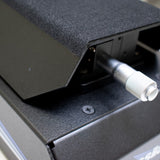Conductivity vs Resistivity vs Resistance
Conductivity, resistivity, resistance and sheet resistance are all electrical quantities that describe a material or an electrical component’s opposition to electrical current flow. These quantities are all related, but are used to describe different things in different scenarios.
Electrical current is the flow of charged particles through a material. Depending on the material or electrical component, current will be able to flow more easily or less easily. Insulators resist current flow greatly; conductors present little resistance to current flow. Simple definitions of these terms are as follows:
- Resistance: Describes the flow of current through a specific 3D object. This depends on the objects geometry and material properties.
- Resistivity: A material property that describes how much resistance a current experiences in a certain material.
- Conductivity: A material property that describes easily current will flow in a certain material. This is simply the inverse of resistivity.
- Sheet Resistance: Describes the flow of current through a specific 2D object. This can only be used if the thickness of your object or layer is much smaller than its surface area. Sheet resistance can be measured using a four-point probe.
Resistance vs Resistivity
The electrical resistance of a component quantifies how strongly it resists the flow of current. This value is specific to each individual object or component.
An object's resistance depends mainly on the material the object is made from. If the material is conducting, like a metal, then the object has low resistance. If the object is made from an insulating material, it will have a high resistance. The general resistance of a material is measured using other metrics, such as resistivity or conductivity.
The geometry of an object also affects its resistance. For example, a longer, thinner wire has a higher resistance than a shorter, thicker one.
Resistivity is an innate property of a given material quantifying its resistance to current flow. This is a material property. In other words, resistivity is fundamental to an object's material only, unlike resistance which depends on both the material and object geometry. A low resistivity is indicative of a material through which current will flow easily.
Resistance is measured in ohms (Ω), wheras resistivity is measured in Ohm-metres, Ω⋅m.
Conductivity vs. Resisitivity
Conductivity is simply the numerical inverse of resistivity of a material. Both resistivity and conductivity describe how difficult it is for electric current to flow through the material in question, intrinsically, with no reference to the shape or size of the collected material.
In other words, conductivity represents how easily current will flow thorugh a material, while resistivity represents how difficult it is for current to flow. When conductivity increases, resistivity decreases.
Conductivity is measured in Siemens per m, S/m (or S/cm). One siemans is the reciprocal of one ohm, S=Ω-1.
Sheet Resistance
Sheet resistance is a quantity that is applicable only in two-dimensional systems. It is the resistivity of a square piece of two-dimensional material - a special case of resistivity for a thin sheet of uniform thickness. The opposite sides of the square in question coincide with the electrical contact points on the thin film made to make a measurement.
Sheet resistance is the quantity directly measured by a four-point probe measurement, not resistivity. For this reason, sheet resistance has wider and easier applicability for measurements of thin films.
Sheet resistance is measured, usually, in Ohms per Square, denoted "Ω/sq" or " Ω/☐”. Sheet resistance is invariant under scaling of the distance between contact points – the size said square - and so can be used to classify materials and devices of any size.
Converting Conducitivity to Resistivity to Resistance or Sheet Resistance
Resistance values, resistivity, conductivity and sheet resistance are all related. However, both resistance and sheet resistance refer to the flow of charge through specific objects. Resistivity and conductivity refer to general material properties. Therefore, to convert these values you may need to use the sample thickness, cross sectional area or length.
Remember, sheet resistance only applied to 2D or near 2D materials, such as thin films. For 3D objects, use the resistance equations. Therefore, you cannot convert sheet resistance to resistance or vice versa.
| Resistance, R | Resistivity, ρ | Conductivity, σ | Sheet Resistance, RS | |
|---|---|---|---|---|
| Resistance, R |
 |
 |
||
| Resistivity, ρ |
 |
 |
 |
|
| Conductivity, σ |
 |
 |
 |
|
| Sheet Resistance, RS |
 |
 |
Where:
- R = resistance
- ρ = resistivity
- σ = conductivity
- RS = sheet resistance
- A = cross sectional area of object
- L = length of object
- w = width of object
- t = thickness of thin film/layer
Four-Point Probe

Learn More...
 Getting Started with the Ossila Four-Point Probe
Getting Started with the Ossila Four-Point Probe
The four-point probe is the most commonly-used piece of equipment for measuring the sheet resistance of a material.
Read more... How to Measure Sheet Resistance using a Four-Point Probe
How to Measure Sheet Resistance using a Four-Point Probe
This guide gives an overview of how to use the Ossila Four-Point Probe System, as well as some general tips and tricks for measuring sheet resistance.
Read more...